Ed Gorman's Blog, page 16
November 1, 2015
from Mystery Scene: 25 YEARS OF KAY SCARPETTA
from Mystery Scene:
25 YEARS OF KAY SCARPETTAOline Cogdill
By OLINE H. COGDILL
25 years can go by in the blink of an eye.
So it was a shock to find out that this year is the 25th anniversary of Patricia Cornwell’s Kay Scarpetta character.
When Post Mortem hit the bookstores in 1990, it was a revelation. Here was a story about a medical examiner that was unflinching in its descriptions about what goes on in the autopsy room.
As the medical examiner of Richmond, Virginia, Scarpetta took readers where they had not gone before, showing how the evidence that a medical examiner can uncover may change an investigation. In many ways, she helped launch a fascination with forensic research.There is no question that Scarpetta was a ground-breaker.
She was on the scene first—before there were the television seriesCSI, NCIS and all the others.
Cornwell’s early novels were a revelation—well plotted, with unusual characters and a lesson in science and forensics for readers.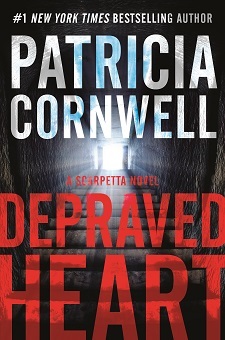
Even those readers who didn’t think they cared about science learned how a lot. And came back for more, novel after novel.Cornwell also has used her success for science.
She has co-founded the Conservation Scientist Chair at the Harvard University Art Museums, and serves as a member of Harvard-affiliated McLean Hospital’s National Council, where she advocates for psychiatric research. She’s helped fund the ICU at Cornell’s Animal Hospital, the scientific study of a Confederate submarine, the archaeological excavation of Jamestown, and a variety of law enforcement charities. Cornwell also has helped fund scholarships and literacy programs.
Depraved Heart, Cornwell’s 23rd novel in her Scarpetta series, is now out.
The plot touches on the suspicious death of a Hollywood mogul’s daughter, aircraft wreckage on the bottom of the sea in the Bermuda Triangle, and videos from a relative’s past that threaten Scarpetta’s personal life.
25 YEARS OF KAY SCARPETTAOline Cogdill

By OLINE H. COGDILL
25 years can go by in the blink of an eye.
So it was a shock to find out that this year is the 25th anniversary of Patricia Cornwell’s Kay Scarpetta character.
When Post Mortem hit the bookstores in 1990, it was a revelation. Here was a story about a medical examiner that was unflinching in its descriptions about what goes on in the autopsy room.
As the medical examiner of Richmond, Virginia, Scarpetta took readers where they had not gone before, showing how the evidence that a medical examiner can uncover may change an investigation. In many ways, she helped launch a fascination with forensic research.There is no question that Scarpetta was a ground-breaker.
She was on the scene first—before there were the television seriesCSI, NCIS and all the others.
Cornwell’s early novels were a revelation—well plotted, with unusual characters and a lesson in science and forensics for readers.

Even those readers who didn’t think they cared about science learned how a lot. And came back for more, novel after novel.Cornwell also has used her success for science.
She has co-founded the Conservation Scientist Chair at the Harvard University Art Museums, and serves as a member of Harvard-affiliated McLean Hospital’s National Council, where she advocates for psychiatric research. She’s helped fund the ICU at Cornell’s Animal Hospital, the scientific study of a Confederate submarine, the archaeological excavation of Jamestown, and a variety of law enforcement charities. Cornwell also has helped fund scholarships and literacy programs.
Depraved Heart, Cornwell’s 23rd novel in her Scarpetta series, is now out.
The plot touches on the suspicious death of a Hollywood mogul’s daughter, aircraft wreckage on the bottom of the sea in the Bermuda Triangle, and videos from a relative’s past that threaten Scarpetta’s personal life.
Published on November 01, 2015 12:29
October 31, 2015
PETER STRAUB’S TOP TWENTY HORROR NOVELS
PETER STRAUB’S TOP TWENTY HORROR NOVELSShirley Jackson The Haunting of Hill HouseRay Bradbury Something Wicked This Way ComesStephen King ItPeter Straub Ghost StoryAnne Rice Interview with the VampireBret Easton Ellis American PsychoWilliam Golding Lord of the FliesRamsey Campbell The Doll Who Ate His MotherAlan Moore and Eddie Campbell From HellKathe Koja SkinThomas Tessier Fog HeartIra Levin Rosemary’s BabyThomas Tryon Harvest HomeT.E.D. Klein The CeremoniesPoppy Z. Brite Exquisite CorpseThomas Harris Red DragonSusan Hill The Woman in BlackJonathan Carroll After SilenceDan Simmons Song of KaliCarlos Fuentes Aura
Published on October 31, 2015 09:45
October 29, 2015
Forgotten Books: Appointment In Samarra & Butterfield 8
BER 29, 2015Forgotten Books: Appointment In Samarra & Butterfield 8
“To me, O’Hara is the real Fitzgerald.”
—Fran Lebowitz, The Paris Review, 1993
Ed here: Fine as Fran Lebowitz's piece on John O'Hara is I can't agree with her that O'Hara was Fitzgerald's equal. He wasn't nearly as good a stylist, he lacked the range of skills Fitzgerald brought to the page and his work rarely had the echoes found in even some of Fitzgerald's magazine stories. But how O'Hara has slipped from view, I dunno. His gifts were extraordinary. He understood America's class system in a way not even Fitzgerald did and despite his braggadocio he did indeed get his time and his generation down without peer. He can still move and delight me over and over; shabby as some of his bestsellers might have been his enormous body of work belongs on the same shelf as Steinbeck, with Appointment in Samarra its masterpiece.Born in 1905 in Pennsylvania coal country, the son of a small-town doctor, John O’Hara leapt to prominence with his first novel, Appointment in Samarra (1934), about the downfall of a car dealer in the fictional town of Gibbsville, Pa. With his second novel, BUtterfield 8 (1935), O’Hara turned his sights on Manhattan and produced one of the great novels of New York in the Depression. For the next three decades, his fiction shuttled back and forth between Gibbsville and New York. Many of his short stories have stood the test of time, but as a novelist he never surpassed his first efforts. His novels of the mid-thirties are his classics, and they deserve to be much more famous than they are.
According to Fran Lebowitz, O’Hara is underrated “because every single person who knew him hated him.” This is an exaggeration, as O’Hara’s biographers (most notably Geoffrey Wolff) have shown, but he could be unpleasant, and his personality sometimes overshadowed his genius. When he was drinking (roughly, from 1919 to 1954), he was notorious for picking fights with whoever had the bad luck to be standing at the other end of a bar. Sobriety curbed his temper, but not his violent yearning for recognition or his self-punishing snobbery. In later life, O’Hara still cadged matchbooks from clubs that wouldn’t have him as a member, and he demanded from his publishers not just high advances but also gifts and lunches at the Ritz. He was addicted to the tokens of success. O’Hara spent particular energy lobbying Yale for an honorary degree, in vain: as then president Kingman Brewster explained, “He wanted it too much.”
Yale comes up a lot in BUtterfield 8 and in much of O’Hara’s later fiction. It was a sort of obsession of his. (Ernest Hemingway once took up a collection “to send O’Hara to New Haven”: O’Hara was in his thirties at the time.) To his lasting chagrin, he never attended college. When he was still in high school, his father died suddenly, leaving the family penniless. From the time he was a teenager, O’Hara supported himself with his typewriter, first as a reporter in Pennsylvania, then in New York, later by writing fiction. Over the years he published 247 stories in The New Yorker (still a record) and a string of best sellers, but he never got over the change in his family’s fortunes, for the O’Haras had lived well when he was a boy, and he never stopped feeling locked out of the upper class. He was morbidly conscious of being Irish American. As his alter ego in BUtterfield 8, the beat reporter Jimmy Malloy explains to the debutante Isabel Stannard: “I am a Mick. I wear Brooks clothes and I don’t eat salad with a spoon and I could probably play five-goal polo in two years, but I am a Mick. Still a Mick … The people who think I am a Yale man aren’t very observing about people.” For O’Hara, this was an ultimate condemnation, both of the unobserving people and of himself. for the rest go here:http://www.newyorker.com/online/blogs...
POSTED BY ED GORMAN AT 11:56 AM 6 COMMENTS: LINKS TO THIS POST
“To me, O’Hara is the real Fitzgerald.”
—Fran Lebowitz, The Paris Review, 1993
Ed here: Fine as Fran Lebowitz's piece on John O'Hara is I can't agree with her that O'Hara was Fitzgerald's equal. He wasn't nearly as good a stylist, he lacked the range of skills Fitzgerald brought to the page and his work rarely had the echoes found in even some of Fitzgerald's magazine stories. But how O'Hara has slipped from view, I dunno. His gifts were extraordinary. He understood America's class system in a way not even Fitzgerald did and despite his braggadocio he did indeed get his time and his generation down without peer. He can still move and delight me over and over; shabby as some of his bestsellers might have been his enormous body of work belongs on the same shelf as Steinbeck, with Appointment in Samarra its masterpiece.Born in 1905 in Pennsylvania coal country, the son of a small-town doctor, John O’Hara leapt to prominence with his first novel, Appointment in Samarra (1934), about the downfall of a car dealer in the fictional town of Gibbsville, Pa. With his second novel, BUtterfield 8 (1935), O’Hara turned his sights on Manhattan and produced one of the great novels of New York in the Depression. For the next three decades, his fiction shuttled back and forth between Gibbsville and New York. Many of his short stories have stood the test of time, but as a novelist he never surpassed his first efforts. His novels of the mid-thirties are his classics, and they deserve to be much more famous than they are.
According to Fran Lebowitz, O’Hara is underrated “because every single person who knew him hated him.” This is an exaggeration, as O’Hara’s biographers (most notably Geoffrey Wolff) have shown, but he could be unpleasant, and his personality sometimes overshadowed his genius. When he was drinking (roughly, from 1919 to 1954), he was notorious for picking fights with whoever had the bad luck to be standing at the other end of a bar. Sobriety curbed his temper, but not his violent yearning for recognition or his self-punishing snobbery. In later life, O’Hara still cadged matchbooks from clubs that wouldn’t have him as a member, and he demanded from his publishers not just high advances but also gifts and lunches at the Ritz. He was addicted to the tokens of success. O’Hara spent particular energy lobbying Yale for an honorary degree, in vain: as then president Kingman Brewster explained, “He wanted it too much.”
Yale comes up a lot in BUtterfield 8 and in much of O’Hara’s later fiction. It was a sort of obsession of his. (Ernest Hemingway once took up a collection “to send O’Hara to New Haven”: O’Hara was in his thirties at the time.) To his lasting chagrin, he never attended college. When he was still in high school, his father died suddenly, leaving the family penniless. From the time he was a teenager, O’Hara supported himself with his typewriter, first as a reporter in Pennsylvania, then in New York, later by writing fiction. Over the years he published 247 stories in The New Yorker (still a record) and a string of best sellers, but he never got over the change in his family’s fortunes, for the O’Haras had lived well when he was a boy, and he never stopped feeling locked out of the upper class. He was morbidly conscious of being Irish American. As his alter ego in BUtterfield 8, the beat reporter Jimmy Malloy explains to the debutante Isabel Stannard: “I am a Mick. I wear Brooks clothes and I don’t eat salad with a spoon and I could probably play five-goal polo in two years, but I am a Mick. Still a Mick … The people who think I am a Yale man aren’t very observing about people.” For O’Hara, this was an ultimate condemnation, both of the unobserving people and of himself. for the rest go here:http://www.newyorker.com/online/blogs...
POSTED BY ED GORMAN AT 11:56 AM 6 COMMENTS: LINKS TO THIS POST

Published on October 29, 2015 17:58
Forgotten Books: Appointment In Samarra & Butterfield 8
“To me, O’Hara is the real Fitzgerald.”
—Fran Lebowitz, The Paris Review, 1993
Ed here: Fine as Fran Lebowitz's piece on John O'Hara is I can't agree with her that O'Hara was Fitzgerald's equal. He wasn't nearly as good a stylist, he lacked the range of skills Fitzgerald brought to the page and his work rarely had the echoes found in even some of Fitzgerald's magazine stories. But how O'Hara has slipped from view, I dunno. His gifts were extraordinary. He understood America's class system in a way not even Fitzgerald did and despite his braggadocio he did indeed get his time and his generation down without peer. He can still move and delight me over and over; shabby as some of his bestsellers might have been his enormous body of work belongs on the same shelf as Steinbeck, with Appointment in Samarra its masterpiece.Born in 1905 in Pennsylvania coal country, the son of a small-town doctor, John O’Hara leapt to prominence with his first novel, Appointment in Samarra (1934), about the downfall of a car dealer in the fictional town of Gibbsville, Pa. With his second novel, BUtterfield 8 (1935), O’Hara turned his sights on Manhattan and produced one of the great novels of New York in the Depression. For the next three decades, his fiction shuttled back and forth between Gibbsville and New York. Many of his short stories have stood the test of time, but as a novelist he never surpassed his first efforts. His novels of the mid-thirties are his classics, and they deserve to be much more famous than they are.
According to Fran Lebowitz, O’Hara is underrated “because every single person who knew him hated him.” This is an exaggeration, as O’Hara’s biographers (most notably Geoffrey Wolff) have shown, but he could be unpleasant, and his personality sometimes overshadowed his genius. When he was drinking (roughly, from 1919 to 1954), he was notorious for picking fights with whoever had the bad luck to be standing at the other end of a bar. Sobriety curbed his temper, but not his violent yearning for recognition or his self-punishing snobbery. In later life, O’Hara still cadged matchbooks from clubs that wouldn’t have him as a member, and he demanded from his publishers not just high advances but also gifts and lunches at the Ritz. He was addicted to the tokens of success. O’Hara spent particular energy lobbying Yale for an honorary degree, in vain: as then president Kingman Brewster explained, “He wanted it too much.”
Yale comes up a lot in BUtterfield 8 and in much of O’Hara’s later fiction. It was a sort of obsession of his. (Ernest Hemingway once took up a collection “to send O’Hara to New Haven”: O’Hara was in his thirties at the time.) To his lasting chagrin, he never attended college. When he was still in high school, his father died suddenly, leaving the family penniless. From the time he was a teenager, O’Hara supported himself with his typewriter, first as a reporter in Pennsylvania, then in New York, later by writing fiction. Over the years he published 247 stories in The New Yorker (still a record) and a string of best sellers, but he never got over the change in his family’s fortunes, for the O’Haras had lived well when he was a boy, and he never stopped feeling locked out of the upper class. He was morbidly conscious of being Irish American. As his alter ego in BUtterfield 8, the beat reporter Jimmy Malloy explains to the debutante Isabel Stannard: “I am a Mick. I wear Brooks clothes and I don’t eat salad with a spoon and I could probably play five-goal polo in two years, but I am a Mick. Still a Mick … The people who think I am a Yale man aren’t very observing about people.” For O’Hara, this was an ultimate condemnation, both of the unobserving people and of himself. for the rest go here:http://www.newyorker.com/online/blogs...
POSTED BY ED GORMAN AT 11:56 AM 6 COMMENTS: LINKS TO THIS POST

SATURDAY, JULY 12, 2008BackstoryYes, another cranky post from Gorman...
Tonight Patti Abbott talks about the use of backstory in fiction. I thought I'd post my response here.
One of the reasons I read so little contemporary hardboiled crime fiction is because there is so little character development. The old hardboiled stuff had its character cliches but so does the new stuff. You see same characters again and again all comepeting to be cool and stylish in that neo-noir way.
This is probably my age showing yet again. But I grew up reading Hemingway and Falkner and Fitzgerald and John O'Hara and Irwin Shaw (short stories) and Cheever and I was always aware that some of their greatest art was in how they used backstory to enrich the reading experience. Hell, some of their best writing and most stunning observation was in the backstory.
And I found the same thing in JohnD, Charles Williams, Peter Rabe, Vin Packer, W.R. Burnett etc.
I realize that fiction has changed, in many respects for the better, but terseness for the sake of terseness gets tiresome to me.
If you want to know how backstory can be just as powerful and compelling as fron story (and not slow the action) I recommend reading Appointment in Samarra by John O'Hara.
POSTED BY ED GORMAN AT 1:44 PM 4 COMMENTS: LINKS TO THIS POST

MONDAY, MAY 13, 2013
Published on October 29, 2015 14:03
Pro-File-Stephen Mertz
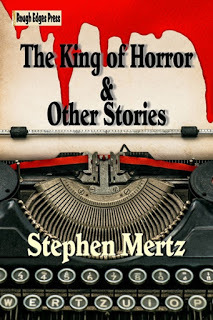 Stephen Mertz is best known for his mainstream thrillers and novels of suspense. His work covers a wide variety of styles from paranormal dark suspense (Night Wind and Devil Creek) to historical thrillers (Hank & Muddy), hardboiled noir (Fade to Tomorrow) and even over-the-top steampunk (Sherlock Holmes: Zombies Over London). He is the creator of the popular Blaze! western series, written in collaboration with others, published by Rough Edges Press.
Stephen Mertz is best known for his mainstream thrillers and novels of suspense. His work covers a wide variety of styles from paranormal dark suspense (Night Wind and Devil Creek) to historical thrillers (Hank & Muddy), hardboiled noir (Fade to Tomorrow) and even over-the-top steampunk (Sherlock Holmes: Zombies Over London). He is the creator of the popular Blaze! western series, written in collaboration with others, published by Rough Edges Press. Steve’s novels have been well-received critically. Edgar-winning bestseller Joe R. Lansdale praises Steve for writing “a hard-edged thriller for those who like their tales straight and sharp and full of dark surprise.” And this from Edgar Award winning author Max Allan Collins, author of Road to Perdition: "Stephen Mertz is one of my favorite novelists...a wonderful writer." Author Paul Bishop recently wrote that, “Any book by Stephen Mertz is guaranteed to entertain.” Booklist called Night Wind, “fast-paced...a white-knuckle read,” and The Korean Intercept, “an adrenaline rush!” Ellery Queen’s Mystery Magazine labeled Stephen Mertz, “an action specialist."
Steve has traveled widely and is a U.S. Army veteran. He presently lives in the American Southwest, and he is always at work on a new book.
PRO FILE:
Tell us about your current book.
I’m proud of this one. The King of Horror & Other Stories is a complete collection of my short fiction, with an Introduction by Evan Lewis and a new afterword by me. Oh, and one new story never before published.
2. Can you give a sense of what you're working on now?
I keep coming back to a novel I can’t seem to finish about Jimi Hendrix.
3. What is the greatest pleasure of a writing career?
Writing. Knowing writers. Reading.
4. What is the greatest DISpleasure?
Bad writing.
5. If you have one piece of advice for the publishing world, what is it?
This may surprise you but I don’t have any advice for them. This is probably the best time to be a writer since I broke in as a writer. The so-called legacy houses and agencies got what they deserved and, one hopes, are in the process of realigning with the new publishing paradigm, and the digital publishing world is an explosion of markets unseen since the birth of television and the paperback original. I’m old school enough to prefer “real” books as a reader, but my writing revenue these days comes from my e-publishers, Crossroads Press and Rough Edges Press. I’m writing what I want to write. People are reading what I’m writing, and seem to like it. Revenue is being generated. More of the same, please!
6. Are there two or three forgotten mystery writers you'd like to see
in print again?
There should be more Ennis Willie available! When it comes to hardboiled, he’s the best “unknown” there is.
7. Tell us about selling your first novel. Most writers never forget
that moment.
Some Die Hard. Just re-published by Rough Edges Press with a new afterword by me recounting how I managed to finagle my money out of the original publisher (crooked bastards) with the help of a mime and…well, heck, buy the book! It’s still the only locked room mystery I ever heard of where a guy is murdered with a knife while flying alone in his glider…
(from James Reasoner's great website Rough Edges)
Now Available: The King of Horror & Other Stories- Stephen Mertz
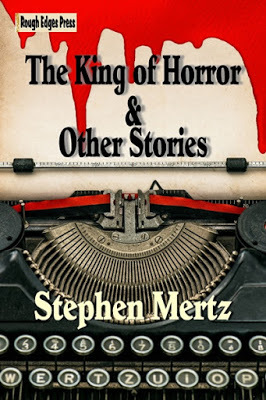
"One of my favorite writers...a born storyteller...Enjoy!" – Max Allan Collins
"Stephen Mertz writes a hard-edged, fast-paced thriller for those who like their tales straight and sharp." — Joe R. Lansdale
For the past forty years, Stephen Mertz has been a bestselling author of thrillers and men's adventure novels, while also becoming known as one of the best mystery writers in the business. THE KING OF HORROR & OTHER STORIES, the complete collection of his short fiction, showcases the wide variety of his work, from Westerns and historicals to hardboiled private eye yarns to pure pulp adventure and razor-sharp suspense.
Featuring an introduction by Evan Lewis and an afterword by Stephen Mertz, the stories in this volume include:
The King of Horror
The Death Blues
Fragged
Talon's Gift
The Lizard Men of Blood River
The Busy Corpse
Take Two
The Basics of Murder
The Dark of Midnight
Last Stand
A Hit for the New Age
Relic
Rough Edges Press is proud to present THE KING OF HORROR & OTHER STORIES.
Posted by James Reasoner at 6:59 AM 2 comments:

Email ThisBlogThis!Share to TwitterShare to FacebookShare to Pinterest
Published on October 29, 2015 08:18
October 28, 2015
Donald Hamilton/Matt Helm from Titan Books
Ed here: As I've noted before I never really took to James Bond in print or in the movies probably because I've never been fan of camp. That JFK took to him always disappointed me. It revealed the privilege that informed too much of his life. Personal opinion only of course.
Matt Helm was much closer to the real deal. Allan Dulles, the most sociopathic of all our Cold Warrior political psychopaths would probably have built a shrine to Helm. Which is to say that Helm was a true blue Cold Warrior himself, so certain in his job of destroying Communism that assassinating people rarely troubled him morally.
But Hamilton was so skilled in presenting him, so deft at making Helm's war our own, that we at least understood him if not always agreed with him. The novels remain fresh today and given Putin's recent sociopathic moves) even the Cold War atmospherics are once again realistic.
Unlike all the writers influenced by Ian Fleming and other upper crust British espionage novelists, Matt Helm is very much blue collar. Parts of his books set in the American west read like early Elmore Leonard westerns. Like most workingmen and workingwomen, he knows how to do stuff, whether it's fixing the hinges on a door getting an obstinate car to start.
They are nodal available again beautiful inexpensive editions. Buy them now.

Matt Helm - The Devastators
Mass market paperback
Donald Hamilton
RRP £7.99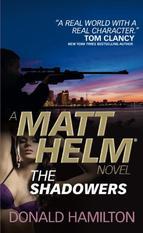
Matt Helm - The Infiltrators
Mass market paperback
Donald Hamilton
RRP £7.99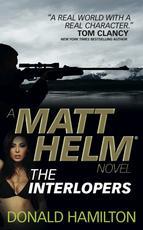
Matt Helm - The Interlopers
Mass market paperback
Donald Hamilton
RRP £7.99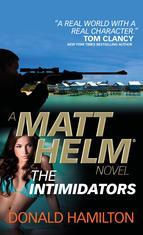
Matt Helm - The Intimidators
Mass market paperback
Donald Hamilton
RRP £7.99
Matt Helm - The Intriguers
Mass market paperback
Donald Hamilton
RRP £7.99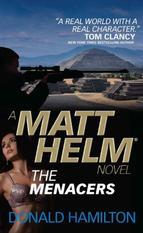
Matt Helm - The Menacers
Mass market paperback
Donald Hamilton
RRP £7.99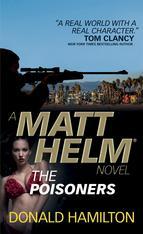
Matt Helm - The Poisoners
Mass market paperback
Donald Hamilton
RRP £7.99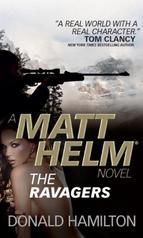
Matt Helm - The Ravagers
Mass market paperback
Donald Hamilton
RRP £7.99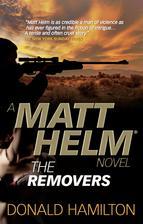
Matt Helm - The Removers
Mass market paperback
Donald Hamilton
RRP £7.99
Matt Helm - The Retaliators
Mass market paperback
Donald Hamilton
RRP £7.99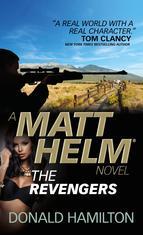
Matt Helm - The Revengers
Mass market paperback
Donald Hamilton
RRP £7.99
Matt Helm - The Shadowers
Mass market paperback
Donald Hamilton
RRP £7.99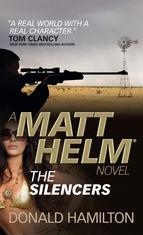
Matt Helm - The Silencers
Mass market paperback
Donald Hamilton
RRP £7.99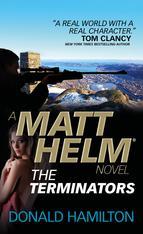
Matt Helm - The Terminators
Mass market paperback
Donald Hamilton
RRP £7.99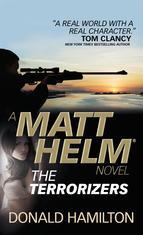
Matt Helm - The Terrorizers
Mass market paperback
Donald Hamilton
RRP £7.99
Matt Helm was much closer to the real deal. Allan Dulles, the most sociopathic of all our Cold Warrior political psychopaths would probably have built a shrine to Helm. Which is to say that Helm was a true blue Cold Warrior himself, so certain in his job of destroying Communism that assassinating people rarely troubled him morally.
But Hamilton was so skilled in presenting him, so deft at making Helm's war our own, that we at least understood him if not always agreed with him. The novels remain fresh today and given Putin's recent sociopathic moves) even the Cold War atmospherics are once again realistic.
Unlike all the writers influenced by Ian Fleming and other upper crust British espionage novelists, Matt Helm is very much blue collar. Parts of his books set in the American west read like early Elmore Leonard westerns. Like most workingmen and workingwomen, he knows how to do stuff, whether it's fixing the hinges on a door getting an obstinate car to start.
They are nodal available again beautiful inexpensive editions. Buy them now.

Matt Helm - The Devastators
Mass market paperback
Donald Hamilton
RRP £7.99

Matt Helm - The Infiltrators
Mass market paperback
Donald Hamilton
RRP £7.99

Matt Helm - The Interlopers
Mass market paperback
Donald Hamilton
RRP £7.99

Matt Helm - The Intimidators
Mass market paperback
Donald Hamilton
RRP £7.99

Matt Helm - The Intriguers
Mass market paperback
Donald Hamilton
RRP £7.99

Matt Helm - The Menacers
Mass market paperback
Donald Hamilton
RRP £7.99

Matt Helm - The Poisoners
Mass market paperback
Donald Hamilton
RRP £7.99

Matt Helm - The Ravagers
Mass market paperback
Donald Hamilton
RRP £7.99

Matt Helm - The Removers
Mass market paperback
Donald Hamilton
RRP £7.99

Matt Helm - The Retaliators
Mass market paperback
Donald Hamilton
RRP £7.99

Matt Helm - The Revengers
Mass market paperback
Donald Hamilton
RRP £7.99

Matt Helm - The Shadowers
Mass market paperback
Donald Hamilton
RRP £7.99

Matt Helm - The Silencers
Mass market paperback
Donald Hamilton
RRP £7.99

Matt Helm - The Terminators
Mass market paperback
Donald Hamilton
RRP £7.99

Matt Helm - The Terrorizers
Mass market paperback
Donald Hamilton
RRP £7.99
Published on October 28, 2015 12:42
Stages of a Fiction Writer by Dean Wesley Smith

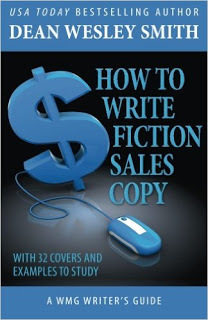
Allyson Longueira is publisher of WMG Publishing. She is an award-winning writer, editor and designer.
I’ve told you how busy Dean Wesley Smith keeps himself. And this month is no different. But this time, I’m talking about nonfiction (yeah, he writes that, too). He has two new nonfiction books coming out—one tomorrow and one as part of the NaNoWriMo Storybundle on October 28—and hasn’t slowed down yet.In the first book, Stages of a Fiction Writer, Dean shares his vast experience and observations on the various phases a fiction writer goes through as he or she evolves in the craft.Here’s the synopsis:
With more than a hundred published novels and more than seventeen million copies of his books in print, USA Todaybestselling author Dean Wesley Smith knows how to write fiction. And he has traversed every stage of writing along the way.In this WMG Writer’s Guide, Dean takes you step-by-step through the stages most fiction writers go through and how not to lose hope along the way.Want to enjoy your writing more and let your storytelling evolve in its own time? Then learn from Dean’s experience and discover what to expect at each stage of a fiction writer’s career.
In the second book, How to Write Fiction Sales Copy, Dean takes all those blurbs from the 32 stories he wrote for Stories from July and analyzes what approach he took to creating the blurb as well as what makes for good sales copy writing.Here’s the synopsis:
USA Today bestselling author and former publisher Dean Wesley Smith knows how to navigate the complicated world of publishing. And now, he shares his experience to help writers tackle the most challenging writing of all: Fiction Sales Copy.In this WMG Writer’s Guide, Dean addresses the major challenges that lead to bad sales copy—including using passive voice and too much plot—and offers 32 examples from his own stories to illustrate his points.Want to make your books stand out from the pack and grab the reader’s attention? Then learn from Dean’s experience and discover how to write copy that best sells your stories.
Dean offers a unique perspective in the world of writing how-to, and his blog draws thousands of visitors weekly. Erin M. Hartshorn, of Vision: A Resource for Writers, says: “Dean Wesley Smith’s blog gives both a slightly different view of the publishing world than I’d seen before and detailed hands-on ‘here’s how to get from A to B’ instruction.”So, if you want to improve your fiction writing or just understand the process writers go through a little better, check out these books.Happy writing.Allyson Longueira is publisher of WMG Publishing. She is an award-winning writer, editor and designer.
Published on October 28, 2015 07:11
October 27, 2015
MURDER DRAWS A CROWD The Fredric Brown Mystery Library, Volume One
.

MURDER DRAWS A CROWD
The Fredric Brown Mystery Library, Volume One
Introduction
by Jack Seabrook
ISBN: 9781893887787
744 pages
Over 100 illustrations
39 pulp magazine stories:• Detective • Mystery • Horror • Western
100-pg appendix with the “V.O.N. Munchdriller” &
“William Z. Williams” comedies
Decorated endpapers
Smythe-sewn bindingFull cloth-covered binding boards
Shipping November 10, 2015
Preorder: $40
On publication: $45- See more at: http://www.haffnerpress.com/news-even...
CONTENTS LIST

MURDER DRAWS A CROWD
The Fredric Brown Mystery Library, Volume One
Introduction
by Jack Seabrook
ISBN: 9781893887787
744 pages
Over 100 illustrations
39 pulp magazine stories:• Detective • Mystery • Horror • Western
100-pg appendix with the “V.O.N. Munchdriller” &
“William Z. Williams” comedies
Decorated endpapers
Smythe-sewn bindingFull cloth-covered binding boards
Shipping November 10, 2015
Preorder: $40
On publication: $45- See more at: http://www.haffnerpress.com/news-even...
CONTENTS LIST
The Moon for a Nickel, Detective Story Magazine Mar. 38- See more at: http://www.haffnerpress.com/news-even...
The Cheese on Stilts, Thrilling Detective Jan. 39
Blood of the Dragon, Variety Detective Magazine Feb. 39
There Are Bloodstains in the Alley, Detective Yarns Feb. 39
Murder at 10:15, Clues Detective Stories May 39
The Prehistoric Clue, Ten Detective Aces Jul. 40
Trouble in a Teacup, Detective Fiction Weekly Jul-13-1940
Murder Draws a Crowd, Detective Fiction Weekly Jul-27-1940
Footprints on the Ceiling, Ten Detective Aces Sep. 40
The Little Green Men, The Masked Detective Fall 1940
Town Wanted, Detective Fiction Weekly Sep-7-1940
Herbie Rides His Hunch, Detective Fiction Weekly Oct-19-1940
The Stranger from Trouble Valley, Western Short Stories Nov. 40
The Strange Sisters Strange, Detective Fiction Weekly Dec-28-1940
How Tagrid Got There, unpublished until 1986
Fugitive Imposter, Ten Detective Aces Jan. 41
The King Comes Home, Thrilling Detective Jan. 41
Big-Top Doom, Ten Detective Aces Mar 41
The Discontented Cows, G-Men Detective Mar. 41
Life and Fire, Detective Fiction Weekly Mar-22-1941
Big-League Larceny, Ten Detective Aces Apr. 41 {as by Jack Hobart}
Selling Death Short, Ten Detective Aces Apr. 41
Client Unknown, The Phantom Detective Apr. 41
Your Name in Gold, The Phantom Detective Jun. 41
Here Comes the Hearse, 10-Story Detective Jul. 41 {as by Allen Morse}
Six-Gun Song, 10-Story Detective Jul. 41
Star-Spangled Night, Coronet Jul. 41
Wheels Across the Night, G-Men Detective Jul. 41
Little Boy Lost, Detective Fiction Weekly Aug-2-1941
Bullet for Bullet, Western Short Stories Oct. 41
Listen to the Mocking Bird, G-Men Detective Nov. 41
You’ll End Up Burning!, Ten Detective Aces Nov. 41
Number Bug, Exciting Detective Winter 1941
Thirty Corpses Every Thursday, Detective Tales Dec. 41
Trouble Comes Double, Popular Detective Dec. 41
Clue in Blue, Thrilling Mystery Jan. 42
Death is a White Rabbit, Strange Detective Mysteries Jan. 42
Twenty Gets You Plenty, G-Men Detective Jan. 42
Bloody Murder, Detective Fiction Jan-10-1942Appendix:
The “V.O.N. Munchdriller” stories from The Driller
The “William Z. Williams” stories from Excavating Engineer
Published on October 27, 2015 18:36
It's here!!!!! MURDER DRAWS A CROWD The Fredric Brown Mystery Library, Volume One
.

MURDER DRAWS A CROWD
The Fredric Brown Mystery Library, Volume One
Introduction
by Jack Seabrook
ISBN: 9781893887787
744 pages
Over 100 illustrations
39 pulp magazine stories:• Detective • Mystery • Horror • Western
100-pg appendix with the “V.O.N. Munchdriller” &
“William Z. Williams” comedies
Decorated endpapers
Smythe-sewn bindingFull cloth-covered binding boards
Shipping November 10, 2015
Preorder: $40
On publication: $45- See more at: http://www.haffnerpress.com/news-even...
CONTENTS LIST

MURDER DRAWS A CROWD
The Fredric Brown Mystery Library, Volume One
Introduction
by Jack Seabrook
ISBN: 9781893887787
744 pages
Over 100 illustrations
39 pulp magazine stories:• Detective • Mystery • Horror • Western
100-pg appendix with the “V.O.N. Munchdriller” &
“William Z. Williams” comedies
Decorated endpapers
Smythe-sewn bindingFull cloth-covered binding boards
Shipping November 10, 2015
Preorder: $40
On publication: $45- See more at: http://www.haffnerpress.com/news-even...
CONTENTS LIST
The Moon for a Nickel, Detective Story Magazine Mar. 38- See more at: http://www.haffnerpress.com/news-even...
The Cheese on Stilts, Thrilling Detective Jan. 39
Blood of the Dragon, Variety Detective Magazine Feb. 39
There Are Bloodstains in the Alley, Detective Yarns Feb. 39
Murder at 10:15, Clues Detective Stories May 39
The Prehistoric Clue, Ten Detective Aces Jul. 40
Trouble in a Teacup, Detective Fiction Weekly Jul-13-1940
Murder Draws a Crowd, Detective Fiction Weekly Jul-27-1940
Footprints on the Ceiling, Ten Detective Aces Sep. 40
The Little Green Men, The Masked Detective Fall 1940
Town Wanted, Detective Fiction Weekly Sep-7-1940
Herbie Rides His Hunch, Detective Fiction Weekly Oct-19-1940
The Stranger from Trouble Valley, Western Short Stories Nov. 40
The Strange Sisters Strange, Detective Fiction Weekly Dec-28-1940
How Tagrid Got There, unpublished until 1986
Fugitive Imposter, Ten Detective Aces Jan. 41
The King Comes Home, Thrilling Detective Jan. 41
Big-Top Doom, Ten Detective Aces Mar 41
The Discontented Cows, G-Men Detective Mar. 41
Life and Fire, Detective Fiction Weekly Mar-22-1941
Big-League Larceny, Ten Detective Aces Apr. 41 {as by Jack Hobart}
Selling Death Short, Ten Detective Aces Apr. 41
Client Unknown, The Phantom Detective Apr. 41
Your Name in Gold, The Phantom Detective Jun. 41
Here Comes the Hearse, 10-Story Detective Jul. 41 {as by Allen Morse}
Six-Gun Song, 10-Story Detective Jul. 41
Star-Spangled Night, Coronet Jul. 41
Wheels Across the Night, G-Men Detective Jul. 41
Little Boy Lost, Detective Fiction Weekly Aug-2-1941
Bullet for Bullet, Western Short Stories Oct. 41
Listen to the Mocking Bird, G-Men Detective Nov. 41
You’ll End Up Burning!, Ten Detective Aces Nov. 41
Number Bug, Exciting Detective Winter 1941
Thirty Corpses Every Thursday, Detective Tales Dec. 41
Trouble Comes Double, Popular Detective Dec. 41
Clue in Blue, Thrilling Mystery Jan. 42
Death is a White Rabbit, Strange Detective Mysteries Jan. 42
Twenty Gets You Plenty, G-Men Detective Jan. 42
Bloody Murder, Detective Fiction Jan-10-1942Appendix:
The “V.O.N. Munchdriller” stories from The Driller
The “William Z. Williams” stories from Excavating Engineer
Published on October 27, 2015 18:13
Yesteryear’s Westerns: China 9, Liberty 37 (1978) by Fred Blosser
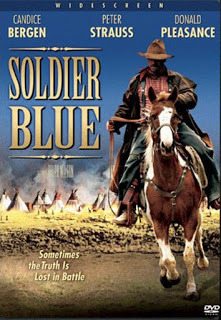
Yesteryear’s Westerns: China 9, Liberty 37 (1978) by Fred Blosser
A lot of different things were going on in western movies over the decade from the mid 1960s to the mid 1970s. There were the traditional films starring old timers like John Wayne (“The Undefeated”) and James Stewart (“The Rare Breed”). There were the violent, closing-of-the-frontier psychodramas of Sam Peckinpah, almost a genre in themselves in terms of the sheer volume of critical writings they have engendered. The spaghetti westerns packed the drive-in theaters, and their American-made offshoots with Clint Eastwood benefitted from the star’s box-office draw, if you’ll excuse the gunslinging puns. There were westerns about teenagers growing up fast when they have to learn to use a six-shooter (“The Spikes Gang”), and revisionist, counter-culture westerns set in muddy, oppressive little frontier towns (“McCabe & Mrs. Miller”). There were Vietnam westerns (“Soldier Blue”), blacksploitation westerns (“Take a Hard Ride”), Nixon westerns (“Chisum”), and Watergate westerns (“Posse”).
By the late ‘70s, all of these categories were on the wane, and the western in general was on extreme life-support. The Duke had made his final film. Peckinpah had two more left, neither one a western. The spaghettis had run their course. And hippie movies, whether set in the past or the present, were passe. The growing conservatism of the Reagan years, coupled with the box-office and critical failure of “Heaven’s Gate” in 1981, would soon slam the lid on counter-culture westerns, at least for a long while.
Monte Hellman’s “China 9, Liberty 37” (1978), an odd Italian-Spanish-U.S. production and one of the few westerns released at the end of the ‘70s, was a late-era summation of the spaghetti, Peckinpah, and revisionist trends. I doubt that it has much appeal for today’s younger audiences, but western fans may be interested in its conglomeration of styles and its somewhat sad attempt to keep the genre alive in the dawning era of “Star Wars.”
In a cliche that reappeared in last year’s ill-conceived reboot of “The Lone Ranger,” big business casts an evil shadow over the frontier. The tycoons of the Great Southern Railroad free pistolero Clayton Drum (Fabio Testi) from hanging when he accepts their assignment to kill homesteader Matthew Sebanek (Warren Oates). Sebanek, once a hired gun for the tycoons himself, owns a patch of land that the railroad wants. Drum and Sebanek strike up a friendship even though Drum has agreed to kill the older man, and Sebanek in turn suspects Drum. The relationship is also strained by a mutual infatuation between Drum and Sebanek’s young wife Catherine. And no wonder, since Catherine is played by Jenny Agutter, and the first time Drum sees her, she’s bathing in a stream nude.
I saw “China 9, Liberty 37” for the first time years and years ago on cable TV. Apparently an edited, pan-and-scan, public domain version is available in various PG-rated DVD editions, minus nude scenes. Watching it again on Turner Classic Movies recently in a nice, properly letterboxed print that restored the skin scenes, I found that the film was better than I remembered from watching it three decades ago on HBO. The romantic scenes drag, in a strange combination of R-rated nudity and soft-focus women’s-fantasy schmaltz, with syrupy background music by Pino Donaggio, but the shootouts are well staged, and Testi, Agutter, and especially Oates offer heartfelt performances.
Sam Peckinpah has a walk-on role as a greedy dime novelist who wants to buy the rights to Drum’s story. “My life isn’t for sale to anyone,” the gunslinger says. “Well,” the dime novelist responds, “it’s only a question of who pays, and when.” With his burned-out, imperturbable alcoholic’s gaze, Peckinpah looks amazingly like Gig Young at the forlorn end of his career in two of Sam’s own movies, “Bring Me the Head of Alfredo Garcia” and “The Killer Elite.”
Published on October 27, 2015 08:24
Ed Gorman's Blog
- Ed Gorman's profile
- 118 followers
Ed Gorman isn't a Goodreads Author
(yet),
but they
do have a blog,
so here are some recent posts imported from
their feed.



